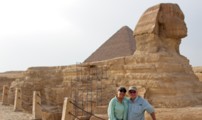Alexandria is the past capital of Egypt and sits at the mouth of the Nile River. Cairo is the current capital and that’s where we’re headed today. Our excursion is called Treasures of Egypt. Good news, it’s cooler. Bad news, it’s another 13-hour day with 3 ½ hours each way on a bus. We’re number 17 in a convoy of about 25 (all going to Cairo; not all on our excursion) with police escorts in front and bringing up the rear and on the sides in most of the cities. We were told it was because of traffic but that does not explain why each bus had an “armed” guard sitting in the front seat! You’d think the Egyptians would be upset at watching this convoy stop all traffic until we pass; but it’s the opposite. Again, smiles and waves from everyone; even the police and officials not connected with the convoy seemed happy to see us.
First stop was at the Museum of Egyptian Antiquities which is supposed to house the world’s largest collection of Egyptian artifacts. This museum is massive but needs a lot of cleaning. Never seen a museum with so much dust and fingerprints. Rooms that say no photographs have no one monitoring so, of course people are using cameras. It’s almost like they don’t know how to protect all the treasures they have. Among its thousands of statues, jewels and artifacts is the sarcophagus of Tutankhamen, the boy-king who ruled Egypt for 9 years.
Once again we were treated to lunch aboard a sailing ship while cruising the Nile; this time a buffet and we were entertained by a male dancer who spun around in a number of skirts for a minimum of at least 10 minutes. We could barely stand upright after watching him. He was able to angle those skirts in all kinds of directions while he spun. Then the traditional belly dancer came out; she wasn’t half as good as her male counterpart.
Off to the Great Pyramids of Giza and The Great Sphinx. At a height of more than 65 ft tall and 240 ft long, the Pyramids sit right on the edge of Cairo. It was odd to see that. Have you ever seen the Pyramids with a city in the background, NO. There are 3; big, medium and small and a few much smaller built for the wives of the pharaohs. We exit the bus knowing we want pictures on a camel so he heads off to find one. Next thing I know, he’s on a camel, the Arab has his camera and is guiding him down a rocky path to the other side of the pyramid. I reach the point where he got on and there’s another Arab with his camel and I assumed my husband had set it up for me so up I go. I’m pretty explicit that all I want is a picture; NO RIDE. This camel heads down the same rocky path and I’m screaming “all I want is a picture”. This really is quite the story and needs to be told, not read. End result was the camel excursion cost us $120 and probably should have been @ $20. However, we do have the memories!
The Great Sphinx is a limestone statue of a reclining mythological creature with the body of a lion and the head of a person. The Egyptians built sphinx statues to guard important areas such as tombs, temples and pyramids. The first thing you notice about The Great Sphinx is that its nose is missing. Legend has it that peasants made offerings to the Sphinx in hope of controlling the flood cycle, which would result in a successful harvest. Outraged by this blatant show of devotion, Sa’lm al-Dahr destroyed the nose and was later executed for vandalism. Whether this is absolute fact is still being debated.
Time to return to our bus for the 3 ½ hour ride back to the ship. On the way, our bus driver manages to side swipe a truck as we try to merge into his lane. That certainly got everyone’s attention in the bus but we just kept on going, funny.

































